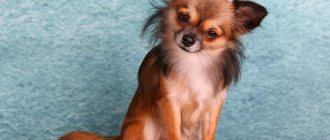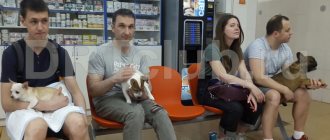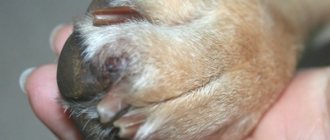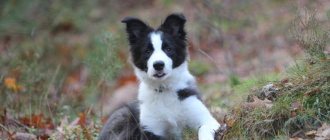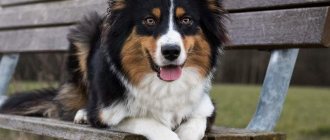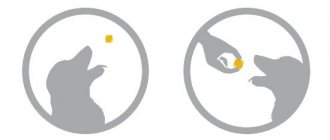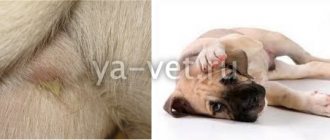If you notice that your animal has become less mobile, it is difficult for him to go down and up the steps, the dog has difficulty jumping onto the sofa, and his gait has become stiff or unsteady - this is a reason to contact a veterinary clinic. If a dog suddenly, even without any apparent reason, suddenly loses its hind legs or even all four legs, contact should be made immediately! The above symptoms may indicate such a serious disease as discopathy.
Discopathy is a disease common to many chondrodystrophoid breeds of dogs. These include dachshunds, Pekingese, pugs, and French bulldogs. Most often, animals between 4 and 8 years old become ill. Of all the breeds, dachshunds are the most predisposed to discopathy, and account for up to 65% of all dogs with this disease.
Pathology of the intervertebral discs also occurs in dogs of large breeds: Dobermans, German shepherds, American bulldogs, Rottweilers - and, as a rule, is characterized by a slower progression.
Characteristics of the disease
Intervertebral discs consist of a fibrous membrane and a nucleus pulposus. Thanks to them, the hard vertebrae do not touch each other and are not deformed by friction.
When the disease occurs, the soft contents harden. It becomes overgrown with fibrous tissue, and its gelatinous consistency changes to cheesy. The outer shell becomes porous and brittle. Under pressure from the vertebrae, it flattens and collapses.
Due to the displacement of the natural “shock-absorbing cushion”, the nerve roots of the spinal cord are under increasing pressure. If pinched for too long, motor function is lost forever, so it is very important not to self-medicate and seek help at the first sign of discomfort.
Clinical case No. 2
A Chihuahua dog named Hans was admitted to the veterinary office with complaints of stiffness in the spine, as well as weakness in the pelvic limbs after an unsuccessful jump from the sofa. During a clinical examination by veterinary neurologist E.S. Maslova. A neurological deficit of the pelvic limbs of the second degree was discovered. Afterwards, the patient’s blood was taken for analysis, an ultrasound of the heart was performed and, with a full package of documents, he was sent for a CT examination. According to the results, the Chihuahua was found to have an extrusion at the end of the thoracic spine with about 50% occlusion of the spinal canal.
25.05 Hans underwent hemilaminectomy TH11-12. During this operation, the spinal cord is decompressed and the herniation (contents of the intervertebral disc) is removed. After the operation, the animal was transferred to the inpatient department to recover from anesthesia under the supervision of a physician. Hans went home and is now undergoing rehabilitation.
Veterinary surgeon, specialist in traumatology, orthopedics and neurology Maslova E.S. Veterinary anesthesiologist K.V. Litvinovskaya
Author of the article: Veterinarian Anastasia Sergeevna Makhneva
Causes of pathology
The disease occurs against the background of water-salt imbalance and obesity. The risk group includes older dogs and some breeds that are prone to pathological changes in discs on a genetic level.
Breed predisposition
Chondrodystrophic breeds include dogs with abnormally short limbs, weak bones and a long spine. 65% of dogs suffering from discopathy are dachshunds. The second place is occupied by no less miniature Pekingese. The list includes basset hounds and cutie corgis.
Large breeds get sick less often, and their symptoms are much milder. The prognosis for recovery also differs. With timely treatment, large pets recover quickly. If congenital anomalies are to blame, treatment comes down to supportive therapy that slows down degenerative changes.
Elderly age
With aging, the ratio between incoming and outgoing salts and water is disrupted. The tissues of the intervertebral discs do not receive the elements they need and wear out. An additional burden is exerted by excess weight, which appears due to the loss of previous activity.
Symptoms of discopathy
This common disease presents with a wide range of symptoms. Usually the initial stage goes unnoticed by the owner. The pathology of the intervertebral disc can last for several years and practically not show itself. During this time, under the influence of the vertebrae, the disc degenerates in some areas into dense tissue. Already at this stage, you can notice changes in the dog’s movements:
- the animal does not play as actively and may sometimes experience pain during exercise;
- the dog has difficulty lifting (dragging) its paws;
- the animal walks unsteadily;
- the position with an arched back is observed not only during pull-ups;
- Without external damage, the animal cannot tear one of its four limbs off the ground.
In this case, you should immediately see a neurologist and establish the cause and location of the pathological process.
There are often cases when owners attribute symptoms of discopathy to the age of the animal or poor health after recent active exercise. This, as well as the uncontrolled use of painkillers, can blur the picture and postpone a visit to the veterinarian for some more time, during which the disease will worsen and the symptoms will become more obvious.
At the next stage, uncoordinated movement of the hind limbs is observed. The function of urination and defecation may be impaired. As a rule, this picture is characteristic of almost complete destruction of the intervertebral disc. Its damage is irreversible, so timely consultation with a doctor and correct diagnosis help slow down the rate of development of the pathological process.
Symptoms depending on stage
Symptoms and treatments for discopathy in dogs depend on the extent of disc damage. Depending on this, the pathology is divided into 5 stages:
- First
. Despite the absence of external damage, the first pain appears. The pet squeals when it is unsuccessfully picked up by the stomach and becomes restless. Jumping on the sofa and back is becoming more and more difficult, and going down the stairs takes more and more time.
- Second
. Symptoms become more specific. In addition to pain and unusual behavior, gait disturbance is noted. When moving, the animal staggers and collapses its body.
- Third
. The pelvic limbs fail, depriving the dog of the ability to move independently. Because of this, he urinates on himself, but he does it consciously.
- Fourth
. The musculoskeletal function is completely lost, causing uncontrolled urination. Tendon reflexes, caused by the blow of a special hammer, and deep pain sensitivity are preserved.
- Fifth
. Due to severe compression of the spinal cord, the reaction to any kind of pain disappears. No more than 12 hours are given to save a paralyzed animal. After this time, the nerve cells in the spinal cord, deprived of blood flow, die. The animal remains disabled forever.
The initial stage, characterized by mild symptoms, can last 1.5-2 years. If you notice a suspicious decrease in activity, increased sensitivity to touch and painful squealing during exercise, contact your veterinarian.
Don't wait for more serious signs that affect your gait to appear. The more advanced the disease, the less likely it is that your pet will regain its previous mobility.
How to care for a sick dog
A dog suffering from this pathology needs special care. You need to ensure that your pet does not jump onto sofas or other heights and does not jump back.
When going down or going up the stairs, the dog is picked up.
For walks, it is better to choose a soft harness instead of a collar. If surgery has been performed, a special tight corset is put on the dog during the rehabilitation period in order to completely reduce the load on the back.
A sick animal can only be rehabilitated in a clinic under the supervision of a veterinarian.
Classification of the disease
The disease is divided into several forms and types. They differ from each other in the nature of changes in the disc and the location of the lesion.
By the nature of changes in the disk
The violations that occur are called extrusion or protrusion. In the first case, the outer shell ruptures and the inner part leaks directly into the spinal canal. Under pressure, nearby nerves become swollen and inflamed. This form of pathology develops very quickly and is typical for chondrodystrophic breeds under 3 years of age.
In the second case, the disease develops much more slowly. When protrusion occurs, the discs bend and put pressure on the spinal cord, causing it to swell and gradually collapse. This form of pathology is typical for older animals over 7 years old. It does not cause severe discomfort and affects no more than 2 vertebrae.
One more form is distinguished separately. Due to its relatively rare occurrence, it is called "random". The likelihood of developing this form does not depend on breed. Most often it is diagnosed in young pets.
As a result of extrusion or protrusion, which occurs during injury or excessive physical exertion, the nucleus pulposus literally shoots into the spinal canal. Due to the force of the “shot” and the extent of the swelling, instead of gradually developing symptoms, the animal almost immediately develops complete paralysis, characteristic of stages 4 and 5 of the disease. The prognosis for this form of discopathy in dogs is extremely unfavorable.
By localization
Based on the location of the lesion, discopathy is divided into 2 types: cervical (cervical) and dorsal (thoracolumbar). In the first case, the neck suffers from developing disorders, and in the second, the lower back or sternum.
Clinical case of treatment of discopathy in a dog
The French bulldog Samurai was admitted to the Pride Center with pain in the pelvis, tremors and neurological deficit of the pelvic limbs of the 2nd degree. At an appointment with an orthopedic neurologist, a neurological examination was performed, as a result of which the dog was given a preliminary diagnosis of intervertebral disc disease in the lumbar spine. Samurai had blood tests taken, an ultrasound examination of his heart, and he was sent for a computed tomography scan to confirm the diagnosis and determine the location of the prolapsed intervertebral disc. With this disease, it is very important to make a diagnosis and localize the problem as quickly as possible.
A CT scan confirmed a herniated L3-L4 intervertebral disc on the right with extrusion of the nucleus and visible overlap of the spinal canal up to 35%. And on the same day, the neurosurgeon performed a hemilaminetomy operation, which consists of decompression and removal of the prolapsed contents of the disc.
After the operation, Samurai remained under the supervision of doctors in the hospital and later went home. Now Samurai is undergoing rehabilitation and is recovering.
Veterinary surgeon, specialist in traumatology, orthopedics and neurology Maslova E.S. Veterinary anesthesiologist Orlovskaya M.V.
How is the diagnosis carried out?
At the initial stage of the disease, even doctors make mistakes in diagnosis. This is due to the absence of serious damage and the neglect of expensive research methods. The most accurate picture is provided by MRI and myelography. If the veterinarian recommends these tests, do not refuse. Otherwise, it will take much more money to treat your pet, and the chances of its successful recovery will be less.
After collecting an anamnesis, assessing reflexes and determining the sensitivity of the limbs using a clamp and needle holder, as well as receiving results from the above studies, the stage, form and type of pathology are determined. All this allows us to understand how to treat discopathy in dogs, since each case has its own solution.
Anatomy of the spinal column
The spinal column consists of individual vertebrae, which have a complex shape and consist of a body, an arch and processes.
There are five sections in the spine of dogs: cervical ( C
- vertebrae cervicales), thoracic (
T
- vertebrae thoracicae), lumbar (
L
- vertebrae lumbales), sacral (
S
-vertebrae sacrales) and caudal (
Cd
- vertebra caudales).
A dog, like any mammal, always has 7 cervical vertebrae. There are usually 13 thoracic vertebrae, but there may be one more or less (12 or 14). There are usually 7 lumbar vertebrae, but there may be 6 or 8; sacral vertebrae 3 or 4, caudal vertebrae usually from 15 to 25.
Intervertebral discs are cartilaginous pads located between the vertebral bodies throughout the entire spinal column, except from the atlanto-axial joint (between the first and second cervical vertebrae) and the sacral region. There are also intervertebral discs between the caudal vertebrae, but discopathy in this section does not lead to problems with the animal’s health, so it is not an independent medical problem. The main function of intervertebral discs is to act as an elastic shock-absorbing element, absorbing shocks and loads.
The thickness of the intervertebral discs varies from 1.5 to 4 mm. The discs in the thoracic spine are thinner than those in the cervical and lumbar spine.
Anatomically, the disc consists of a gel-like central (pulpous) nucleus and a fibrous (connective tissue) ring. The disc is very strong, as strong as bone.
The nucleus pulposus is a vestige of the notochord. In the intervertebral disc, it is not located in the center, but is slightly shifted upward, towards the spinal canal in which the spinal cord is located.
The spinal cord is located inside a bony canal formed by the processes of the vertebrae and is covered with protective meningeal membranes. Motor and sensory nerve fibers emerge as part of the large spinal nerves in the space between two adjacent vertebrae on each side.
Any compression of the meningeal membranes or roots of the spinal nerves causes severe pain, and compression of the spinal cord itself causes damage to first the superficial (sensitive) and then deeper (motor) nerve fibers, which determines the symptoms of BMPD.
Treatment methods
Treatment without surgery is carried out in dogs with discopathy in the first two stages. In all other cases, conservative therapy is not effective.
Operational
At the third stage, taking medications has virtually no effect, so in most cases the veterinarian recommends a laminectomy. This operation involves removing a fragment of the spinal fissure and replacing the displaced disc. As a result of a laminectomy, the surgeon eliminates compression of the spinal cord, stopping the destruction of nerve cells.
At the fourth stage, the probability of recovery decreases slightly and reaches 90-95%. The most unfavorable prognosis is typical for the fifth stage and the random form of pathology. In most cases, the animal remains permanently disabled, so in particularly difficult situations, the veterinarian may recommend euthanasia.
Please note that the operation helps prevent recurrence of prolapse in the same place. It does not exclude a shift in the opposite direction or the appearance of degenerative changes in the new sector.
Conservative
If the symptoms are limited to pain and partial impairment of mobility, then painkillers, glucocorticosteroids and anti-inflammatory drugs are used to treat the four-legged pet. Thanks to drug therapy, it is possible to relieve existing swelling and cause stable remission for months and even years.
Despite successfully suppressing symptoms, medications cannot restore disc integrity. Discopathy can recur, so to prevent it it is necessary to attend physical procedures prescribed by a veterinarian and strictly adhere to preventive recommendations.
Is it possible to treat a pet at home?
The treatment method for discopathy is selected depending on many factors from the dog’s biography, as well as its general condition. Therefore, complete home treatment is prohibited: the lack of medical advice and prescriptions for many drugs can ruin your pet. But there is a practice of semi-home treatment. In this case, the dog does not remain in the veterinary clinic under constant supervision, but undergoes a full course at home. Thus, you can treat your dog at home, but to ensure its well-being, you cannot do without the attention of a veterinarian.
When self-treating, it is necessary to give the animal all prescribed tablets (Metypred for anti-inflammatory action and other painkillers), and also ensure rest. The dog may have trouble moving. Then it is necessary for a person to be with her at all times: lack of attention, bouts of stress, bedsores and nutritional problems can have a bad effect on the dog’s recovery process. If you understand that you do not have enough time for care, it is better to use the services of a veterinary clinic. The dog will be safe there.
Diet and care
During rehabilitation, the dog is put on a diet, limiting its fat intake. To improve metabolism and stimulate nerve impulses, B vitamins are added to the diet.
On average, recovery takes 1-1.5 months. All this time you need to stay close to the animal. If he is completely paralyzed, he will have to change his diapers and turn him over periodically. Changing positions will help avoid the formation of bedsores. If such care is difficult due to work, arrange to place the dog in a hospital.
In the first days of treatment, activity is reduced to a minimum. After the condition has stabilized and acute symptoms have subsided, physiotherapy is prescribed.
At first, the animal is forced to move around using a stroller. After regularly performing reflex walking exercises, limb mobility returns.
Full walks are returned only after receiving appropriate permission from a doctor. At home and on the street, the operated pet will have to walk in a special corset that fixes the position of the spine. Without it, the discs may become misaligned again.
For what reasons can a pet get sick?
Typically, the process of developing problems with the spine occurs in miniature dogs with weak bones or an elongated back. Therefore, it is Pekingese and burrowing hunting dogs that are most often susceptible to this disease. In this case, medications are almost useless: discopathy of the cervical or thoracic region is essentially breed specific. Large dogs also suffer from discopathy, but in their case it is mild. Their discs are usually not completely destroyed, but this does not eliminate the pain in the back area.
As for dogs in general, older animals with salt metabolism disorders due to their age are at risk. These dogs rarely complete therapy completely. The disease is aggravated by weight problems. In this case, the animal will have difficulty moving during walks and even just walking without the influence of the disease. Therefore, it is important to monitor your pet’s diet, its health status in accordance with its age, provide it with moderate exercise, but refrain from full-fledged physical therapy.
How to massage a hernia without causing harm
General principles
Massage for a spinal hernia can be done immediately after eliminating the main symptoms of an exacerbation.
Here are 5 basic principles of the correct procedure:
- You should not use shock techniques, as they can provoke an aggravation.
- You cannot apply mechanical pressure to the spine - all manipulations are carried out in the paravertebral region.
- The massage should be relaxing, soothing, the patient should experience only a pleasant feeling of relaxation.
- Any increase in pain resulting from the influence of a chiropractor is a sufficient reason to terminate the session.
- It is necessary to massage the back and the affected limb, because as a result of compression of the nerve roots, pain, numbness, and decreased muscle strength occur not only in the back, but also in the limb on the affected side.
Five massage techniques
- Using light circular movements of your palms in the direction from the lower back towards the shoulders and from the paravertebral region to the lateral surfaces of the body, massage the back on the left and then on the right side.
- Using the palms of your hands with light pressure on your back, perform several vertical movements along the spine from the lower back to the neck.
- Visually divide the left and right halves of the back into two more halves with longitudinal lines. Using your fingertips, use gentle pressure in a circular motion to work your back muscles along these mental lines to promote relaxation. Repeat until you feel less muscle tension in your back.
- Perform stroking, rubbing, kneading with your palms: straight and circular movements from the center of the back to the lateral surfaces of the back and slightly upward. This will improve venous drainage from recently cramped muscles, which will reduce the pain and fatigue associated with GP.
- Using your palm with your fingers spread apart, with light force, perform several movements from the bottom up (from the lower back to the shoulder area) on each side of the spinal column.
Best Eyelid surgery for Shar Pei
For a massage course, use cream or massage oil with a calming effect.
You can do this massage every day. This is an excellent remedy for improving overall well-being: it reduces pain and muscle stiffness, restores skin sensitivity and muscle strength in the limbs. And massage for a vertebral hernia in combination with physical therapy helps to form a good muscle corset and prevent exacerbations of HP or reduce the degree of their manifestations.
Back problems in dachshunds
A dangerous disease that is often found in dachshunds is intervertebral disc disease, which manifests itself in two forms: acute (disc rupture due to herniation) and gradually progressive. In dachshunds, the disease most often manifests itself in an acute form.
Dogs have 7 cervical, 13 thoracic, 7 lumbar and 3 sacral vertebrae. Intervertebral discs act as shock absorbers, they reduce the load on the spine. But with age, the intervertebral discs lose elasticity, become rigid and distribute the loads on the spine to a lesser extent. Gradually, with regular exercise, the intervertebral discs compress and expand, bulging outward, and one day a rupture occurs, causing severe pain, nerve damage and even paralysis. Depending on the location of the disc, a certain area of the animal’s body is affected, from the neck to the hind limbs.
Best Why the body instantly turned to stone when the dog died. how to understand that a dog is dying of old age, illness and how to help
Symptoms of intervertebral disc disease
Representatives of the breed are very active, but sometimes their behavior and mood changes
If a dachshund has back pain, it will not be able to directly communicate this to its owner, so it is important to monitor any changes in the pet's behavior
When experiencing back pain, dachshunds walk hunched over and may assume a position in which their back arches strongly. Animals experience weakness and may experience involuntary urination. Appetite decreases, animals may completely refuse food and water, because they feel pain when tilting their heads towards the bowl. When touched, animals suddenly begin to whine in pain, trembling, and loss of coordination are observed.
In severe cases, one or more limbs are paralyzed, resulting in the dog limping or dragging a limb behind it. A “drunk” gait is observed.
Inaction on the part of the owner can lead to the death of the animal caused by sudden cardiovascular collapse.
Treatment and rehabilitation
When contacting a veterinary clinic, a full neurological examination is performed to determine the location of the damaged disc, or to identify other back diseases in dachshunds. The examination includes an MRI, as well as radiography, which allows us to identify other possible causes of the spine, such as fractures, tumors. A spinal tap may be performed to rule out cancer and infectious diseases.
If the dachshund cannot get up on its own to change position, then it is necessary to turn the animal over every few hours to prevent bedsores, as well as help the dog relieve itself, give food and water.
The rehabilitation period includes a number of procedures, including acupuncture or electroacupuncture, to help restore nerve connections in the body.
Passive massage of the limbs and muscles not related to the site of injury can improve blood circulation and lymph circulation.
Laser therapy promotes accelerated recovery of damaged discs and has an analgesic and anti-inflammatory effect.
When the condition improves, other rehabilitation techniques are used to help the body recover. This is how you can encourage your dog to swim in the water.
Forecast
A positive prognosis depends on the duration of clinical signs and the severity of the disease.
Once you have lost sensation in your limbs, your chance of walking again is 50-60% if spinal surgery is performed within 24-48 hours of the injury, and only about 5-20% if surgery is performed more than 48 hours after loss of sensation.
If your dachshund is unable to move but still has sensation in its legs, there is an 85-95% chance that the animal will walk again after surgery. On average, animals recover in 2-6 weeks.
Prevention
Unfortunately, a set of preventive manipulations in the context of conservative treatment simply does not exist. Therefore, the likelihood of intervertebral disc pathologies can be reduced through careful selection work on a particular breed. Only healthy dogs with good pedigree can be allowed to breed. It is also worth monitoring your pet's body weight. Excess weight can create a traumatic load on the damaged spine. With increased weight, the duration of pain will also increase. Therefore, monitor your dog’s health: in 90% of cases, timely treatment and proper recovery after surgery bear fruit.
What to do if your German Shepherd's paws fail, reasons
If a German Shepherd's limbs fail or are completely dehydrated, it is urgently necessary to go to the clinic, we will understand the possible diseases, causes and consequences of the pathology.
Pathologies of joints, bones, injuries and dysplasia
Diseases of the joints and skeletal system can provoke complete or partial failure of their physiological function. Joint diseases (arthritis or arthrosis) occur in adult animals, mainly in old age. Dysplasia of large joints occurs at any age in shepherd dogs.
In dysplasia, mainly large joints are affected, and a process of deformation and destruction of the joint occurs. With a genetic predisposition, there may be initially incorrect physiological formation, which leads to joint dysfunction. Signs of the disorder and the presence of the disease appear from 4 to 6 months in young German Shepherds.
Dysplasia can also occur as an independent disease, without a hereditary predisposition. Unbalanced feeding, poor nutrition with a lack of nutrients, increased body weight, severe stress on the joint beyond age.
Signs and symptoms of dysplasia
- Joint dislocations;
- The dog is limping;
- There may be a staggering gait;
- Activity decreases, moves little;
- Gets up with difficulty;
- The joint may change visually, there is a crunch and swelling.
In case of serious neglect of the condition, treatment is performed surgically. In the early stages of development, pain-relieving drugs and chondroprotectors are prescribed. It is possible to undergo a course of physical therapy. A specially formulated diet and limitation of physical activity will be required.
Spinal problems
Various disorders in the form of injuries, osteochondrosis, severe discopathy destroy the vertebrae, which leads to conduction disturbances and pressure on the brain, and nerves are compressed. Cells of the nervous system begin to decrease in number due to death, impaired movement and weakness in the limbs appear.
- The dog may limp;
- Dragging paws;
- Be completely immobilized.
Competent treatment can help if the owner promptly seeks help from a specialist.
Oncology and benign neoplasms
Unfortunately, often the cause of disruption of physiological movement lies in the appearance of neoplasms that interfere with the normal functioning of the musculoskeletal system.
A tumor can appear anywhere, making it difficult for the entire body to function.
Can be located:
- In the brain;
- On the spine, between disc tumors, hernias;
- Formations in the extremities.
The formation puts pressure on nearby tissues, impedes the conduction of the nervous system, and overloads nerves and blood vessels. They occur mainly in older people, but can also occur in young shepherd dogs.
Unfortunately, the tumor cannot be removed surgically if the owner comes late. Treatment may be symptomatic. If the tumor is malignant and cannot be operated on, the German will have to be euthanized.
Injuries and damage
A German Shepherd can get injured under various circumstances beyond the control of humans. It can be quite serious, causing serious consequences and complications.
The most common damage
- Head injuries;
- Fractures, dislocations;
- Bites;
- Sprain;
- Skull fractures, formation of internal hematomas and ruptures.
External manifestations:
- Bruising, bruising and swelling;
- The dog behaves constrained, whines, movement is limited;
- Chroma or complete immobilization.
